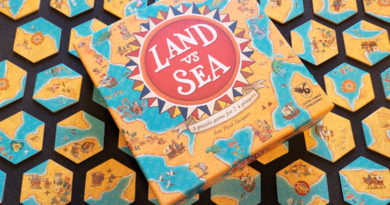Photosynthesis is more than just pretty trees
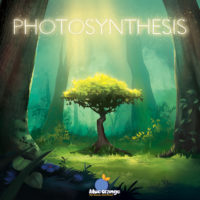
If you know someone who thinks board games are as fun as watching trees grow, how about challenging them to a new board game where you watch trees grow!
Ha – wouldn’t that be fun!
Board games come in all shapes and sizes and cover an unending array of themes. So having a game about growing trees isn’t really too surprising. But making such a game good is another matter.
We’re happy to report that Photosynthesis is a fantastic board game!
And it’s not just due to how wonderful Photosynthesis looks. The game play itself is easy to learn and engaging while also requiring a fair amount of strategy and planning ahead.
Blue Orange Games has published another family board game hit!
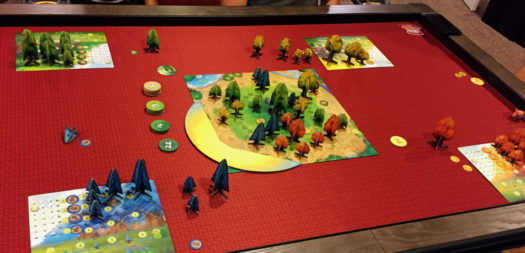
How to play Photosynthesis
Just like ideas the name may conjure up, Photosynthesis is all about harnessing energy from the sun. During the game players will plant seeds, grow them into trees so they can capture the most sunlight, and then harvest them for victory points.
Photosynthesis is really easy to learn.
The game is played over a series of rounds with 2 Phases in each round. At the end of each round, the Sun rotates one spot on the border of the board. The another round occurs. Once the Sun has circled the board three complete times, the game ends.
To begin, each player takes a player board and their corresponding set of colored trees. On each player board, players place 4 Seeds, 4 small trees, 3 medium trees, and 2 large trees. They also set their Light Point tracker on the “0” space of their board. The rest of their Seeds and Trees are placed next to their board in their “Available” area.
Then in turn order, players place one of their Available small trees on an edge space of the main board. They then each place a second available small tree on another edge space. The Sun is placed on the Sun symbol on the board and the game can begin.
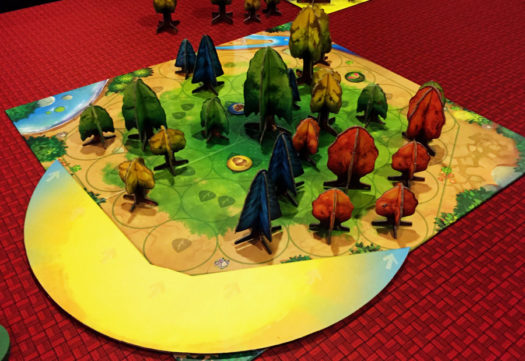
Phase I: The Photosynthesis Phase
At the start of the Photosynthesis Phase, the player with the First Player Token moves the Sun one segment clockwise around the board (except for on the first turn of the game).
Players get Light Points based on the new position of the Sun and their trees. For each tree that’s not in a shadow of another tree, players receive 1 light point for a small tree, 2 points for a medium tree, and 3 points for a large tree.
If a player’s tree is covered in shadow, they don’t get any points for that tree. A small tree casts a shadow 1 space away from the Sun. A medium tree casts a shadow 2 spaces behind it. And a large tree casts a shadow for 3 spaces.
However, a tree standing in a shadow area of another tree will earn light points if it’s taller than the tree casting the shadow.
Players mark their gained light points by moving the Light Point Tracker on their player board that number of spaces forward.
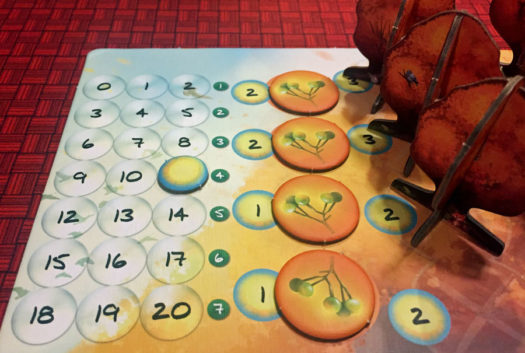
Phase II: The Life Cycle Phase
Once all light points have been gained, players take turns (beginning with whoever has the First Player token) spending their light points for actions.
Buying
Before seeds can be planted and trees grown, they must be in a player’s “Available” area next to their player board. To place the items there, a player must first Buy those items from their player board.
The numbers listed on the player board indicate how much each item costs. Players also much purchase items on their board from bottom to top. For example, the first seed purchased costs 1 light point whereas the first large tree purchased costs 4 light points.
The player places the purchased items in their available area and decreases their Light Point Tracker by the amount they spent.

Planting a Seed
Players can spend light points to plant seeds on the main board. The cost is 1 light point per seed which can be planted around their existing trees. A seed may be planted 1 space away from a small seed, 2 spaces from a medium tree, and 3 spaces from a large tree.
Growing a Tree
Players can also spend light points to grow their trees. A seed or tree can only be replaced by a tree that is the next size up. The cost for growing seeds and trees is indicated at the bottom of the player boards (seed to small tree costs 1, small to medium costs 2, and medium to large costs 3).
The player pays the costs by moving their Light Point Tracker downward that amount. Then they take the next size tree from their available area and place it on the board where they remove the old tree from. The old tree is then placed back on their player board on the topmost space for that size. If no spaces are left open on their board, that seed or tree is removed from the game.
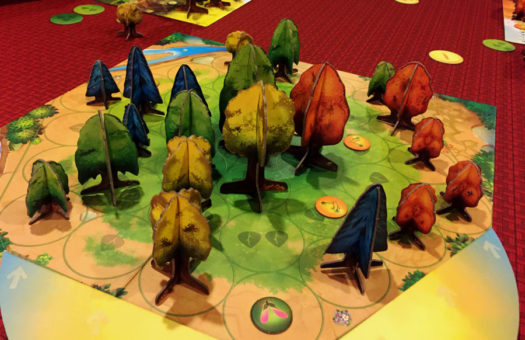
Collecting (Harvesting)
Players can choose when to harvest their Large trees. Doing so costs 4 light points per tree harvested.
The player removes the Large tree from the main board and places it back on their player board. They then collect a Scoring Token from the top of the stack matching the soil type where the tree was rooted. The soil type is shown on the main board spaces as well as on the back of the Scoring Tokens. The Scoring Tokens are stacked in descending order – so the first players to harvest will claim the higher score tokens.
The only catch on all these actions is that players cannot carry out more than one action on the same space of the main board. For example, a player may not plant a Seed in a spot and then immediately grow it into a small tree. Nor can a player plant more than one seed originating from the same tree reference point.

End of Round & Game
After all players have taken their turn in the Life Cycle Phase, the round ends. The First Player token is passed to the player on the left and a new round begins.
When the Sun has completed 3 revolutions around the board, the game end.
Players then add up their score. Any remaining Light Points are converted to Victory Points at a 3 to 1 ratio (every 3 Light Points = 1 Victory Point). They add these Victory Points to the Victory Points listed on the Scoring Tokens they’ve claimed to get their final score.
The player with the most Victory Points wins!
Can the whole family enjoy playing Photosynthesis?
While we’ve already said Photosynthesis is a great family board game, we won’t claim that it’s well suited for everyone in the family.
For starters, there’s plenty of thinking and planning in the game. And that doesn’t go over well with youngsters.
In many of our game reviews we think the age recommendations on the side of the game boys skew high – in that younger players would be fine to give it a go. However, in this case, we actually think the recommended age on the box of 8+ is too low. We’d recommend 10+.
Another caveat is that even some teens and adults may not like the type of economic planning and area control required in Photosynthesis. Every action takes Light Points (essentially the money in the game) and Light Points come from strategic tree placement and growth. Not only that, but players must constantly be planning ahead of the Sun rotations.
Because if your trees aren’t getting sunlight, then you won’t earn any Light Points. Which means you’ll also have less to spend on your next actions.
And if that weren’t enough, there’s also the issue of turn order to take into account. Since turn order also rotates throughout the game, players may have a hard time grabbing the prime locations for planting seeds. Of course, because of the timing and Sun, those “prime” locations will also vary from game to game.
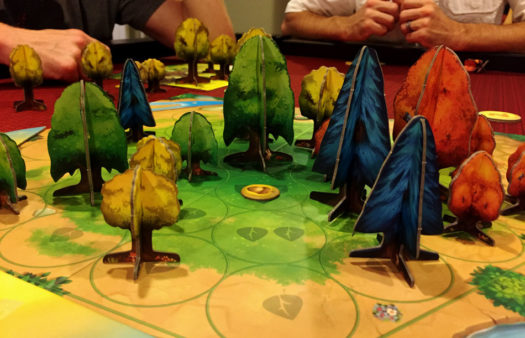
With those issues mentioned then, why do we still consider it a great family board game?
Because most of us in our family enjoy games that require strategy and planning. As our kids have grown, they also enjoy games where there’s lots of player interaction. And Photosynthesis definitely has a lot of player interaction.
Sure you have your own player boards, but you have to compete not only for space, but also for sunlight on the main board every turn!
We also love the Sun rotating around the board. It’s such a cool element of the game!
Not only does it tie so well to the theme, but it also drives where players choose to plant trees, when to grow them taller, and when to harvest them. Harvesting early is great because you get the higher point value Scoring Token. However, keeping a large tree on the board is also nice because it can keep generating light points while also casting shadows on your opponents.

There’s also a fair amount of patience required in playing Photosynthesis.
It takes multiple turns to get a seed planted and then grown to the largest tree size. At a minimum, the total cost to grow and harvest the largest tree from scratch is 20 light points. First you have to Buy the seed and each tree size so they’re available to place on the board. Then you have to spend points to grow them stage by stage. And lastly, you need to spend light points to harvest the large tree. And since you can’t take more than one action from an originating space, those trees take multiple turns to grow through their stages.
The good thing about all that is that players are continuously thinking through their options even when it’s not their turn. Since everyone gains light points at the same time during the Photosynthesis phase, each player knows how much they have to spend on actions when it comes to their turn. The only thing they don’t know is what the other players before them are going to do (ie. where they’ll plant or grow trees). So while there may be some adjusting needed, players can plan most of their actions in advance.
It’s all these choices mixed together in a 3 dimensional, visually appealing board game that keeps us engaged and enjoying the game throughout.
Speaking of visually appealing components, we also want to mention how well designed the trees are. It’s easy to see that each color has their own unique type of tree. But what may not be readily apparent is that they’re also well put together.
Since there’s a lot of picking up and moving of trees during the game, it’s important for the trees to always stay put together. When we first punched out the tree pieces, we thought the crooked cut in one half of the trees was a mistake. But as soon as we put our first tree together it changed to a stroke of genius.
Since the cut in part of each tree isn’t straight, the trees don’t fall apart!
Check out the photo to see for yourself.

How does Photosynthesis score on our “Let’s Play Again” game meter?
 Photosynthesis scores high on our “let’s play again” meter not because it’s a game we play back-to-back, but because of the player interaction and strategic planning required.
Photosynthesis scores high on our “let’s play again” meter not because it’s a game we play back-to-back, but because of the player interaction and strategic planning required.
With 4 players, games run about 45 to 60 minutes. So we typically don’t call for a repeat play as soon as one game ends. But it does have a prominent spot in our game closet because it’s a game we’ll go back to time and again.
If you’re looking for a game with simple rules, straightforward play, short player turns, strategic planning, player interaction, and is visually appealing, then we highly recommend you play Photosynthesis.
We’d like to thank Blue Orange Games for a review copy of Photosynthesis.



